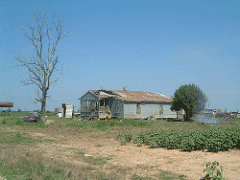
Photo by Flickr user Jimmy Smith
The next administration will face significant housing issues well beyond those related to foreclosures and mortgage markets. The housing needs of low-income people in both urban and rural places predated the housing crash and will undoubtedly outlast it.
One of every five homes in this country is located in a nonmetropolitan area. More than one-quarter of rural households pay more than the federal standard of 30 percent of their monthly income for housing. Most of these cost-burdened rural households have low incomes, and four in 10 are renters.
At the same time, 1.7 million rural homes (6.3 percent) are either moderately or severely substandard. Minorities in rural areas are among the poorest and worst-housed groups in the nation, with much higher levels of inadequate conditions. Complicating efforts to improve rural housing, many rural places lack the kind of nonprofit organization infrastructure that cities have.
Housing needs are particularly severe for certain rural places and populations: Appalachia; the colonias on the U.S.-Mexico border; farm workers; the Mississippi Delta; Native American lands; and the Southern Black Belt.
Despite the needs, funding for the U.S. Department of Agriculture (USDA) rural housing programs has decreased significantly in recent years. At the same time, the ongoing mortgage crisis threatens to erase gains in homeownership and asset-building, while rental units in aging buildings need to be rehabilitated and preserved as affordable housing.
Your administration should act swiftly to address the rural housing crisis by implementing this agenda:
- Protect homeowners against foreclosure when possible, and against predatory lenders in the future. In addition to measures that would help all homeowners and tenants in foreclosed properties, changes that would be particularly important for rural areas include: Helping owners of manufactured homes to obtain standard mortgages to replace the high-cost personal property loans that are often used to purchase these structures; and making special efforts to advertise the availability of Federal Housing Administration (FHA) assistance in rural areas, which have historically been underserved by FHA programs.
- Preserve and revitalize affordable rural rental housing, and protect the tenants of properties that cannot be preserved. Tenants in rental housing developed with USDA direct mortgages have an average income under $11,000 in 2008, and more than half of them are elderly or disabled. These buildings are aging, with many badly in need of repairs and renovations. At the same time, some owners want to leave the USDA program. Federal resources are needed to preserve the taxpayers’ investment in these properties and to save tenants’ homes.
- Implement the recently authorized national housing trust fund, which is targeted to develop rental housing for the very lowest-income Americans.
- Ensure that direct rural housing loans are not replaced by loan guarantees that do not serve the same income levels. USDA makes loans directly to borrowers at low interest rates and also guarantees loans made by private lenders at market rates. The loan guarantee programs have been promoted by the Bush administration because they cost the government less.
Both types of programs are essential for rural America, however. One cannot replace the other because they serve different income levels. In 2006, homebuyers receiving direct loans from USDA had an average income of only $22,992, compared to $40,442 for guaranteed borrowers. And in 2005, USDA reported that the average income for tenants in rental properties financed with direct loans was $8,158 compared to $18,400 for those in developments with guaranteed loans.
- Continue building the capacity of rural housing organizations. Capacity-building programs at both HUD and USDA help local organizations increase their ability to serve their communities and should be supported.
- Recognize the special situations of people who are homeless in rural places. Resources should be available to help people who are either literally homeless or in unstable housing situations; in rural areas, people without homes of their own often find temporary shelter with friends or relatives rather than living on the streets. Homelessness programs should also recognize that in rural areas, small organizations are often the only entities providing services for homeless individuals and families. Since their staff does not always have fundraising experience, they would benefit from simplified funding applications and from capacity-building assistance.
- Protect and fully fund housing programs that serve vulnerable populations. Farm workers, Native Americans and other minorities, and other particularly vulnerable rural populations are served both by programs targeted specifically to them and also by programs targeted to those with very low incomes. These programs, both targeted and not, must be supported.
- Ensure that rural housing programs remain at USDA. Suggestions to move the rural housing programs to the Department of Housing and Urban Development (HUD) ignore the very real differences between rural and urban America. USDA’s expertise and its established network of offices in rural places enable it to deliver housing assistance effectively there.
- Maintain full funding for HUD and USDA housing programs.





Comments